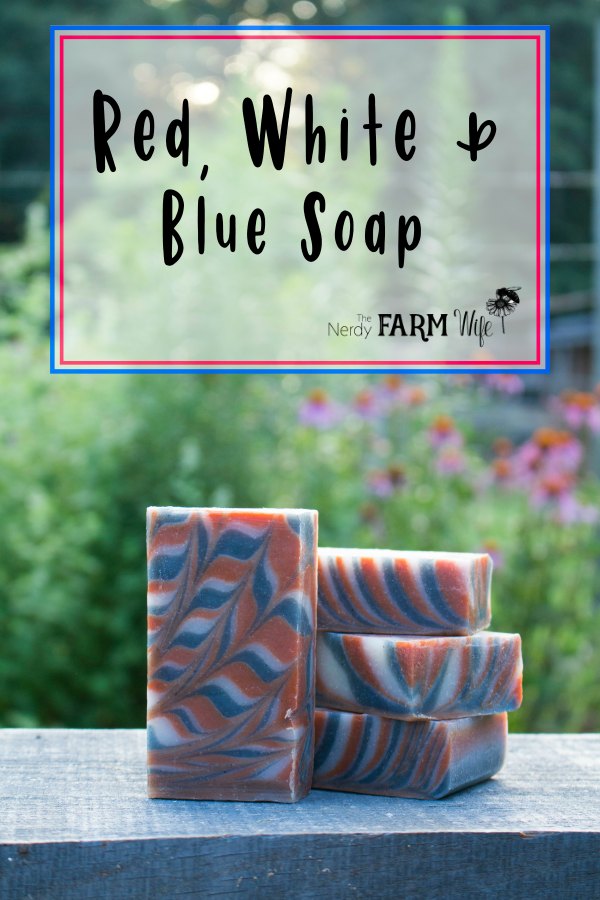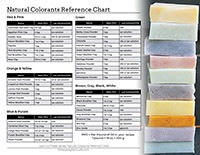Red, White & Blue Swirl Soap with Natural Colorants
This red, white & blue swirl soap is naturally colored with botanicals and clays, and scented with a blend of essential oils.
Credit for the design inspiration goes to Kapia Mera Soap Company (see their lovely soap video HERE), only instead of cutting a thin layer to use for rimmed soap, I cut a thin layer off the top to show the design better and then cut into regular bars.

Natural Soap Colorants Notes
Creating a natural red color in soap is tricky. Red Brazilian clay turns soap a brick red color, rather than a true red, so I blended it with rose clay and madder root, to help tone down the orangey hue some.
You’ll notice the red colorants are listed in two separate mixtures below.
This is because the clays dissolve best in water, while madder root + oil makes the rosier color I was looking for. (Madder root + water can be a little more purple-toned.)
Either woad or indigo will work for the blue, though woad is my favorite blue because it’s less finicky. They mix most easily with glycerin, though you could try mixing them with hot water instead.
In the batch shown, I used 1 teaspoon each of indigo and woad since I ran out of woad powder.
In hindsight, I wish I’d used more zinc oxide for a brighter white, so feel free to double or increase the amount for more contrast.
Your soap needs to go through gel phase to fully develop the colors.]
Natural Colorant Sources
Bramble Berry – red Brazilian clay, rose clay, madder root, indigo, zinc oxide
The Woolery – woad powder

Ingredients for Red, White & Blue Swirl Soap
Lye Solution
- 21.5 oz (610 g) distilled water
- 8.48 oz (241 g) lye (sodium hydroxide) – 5% superfat
Oils & Fats
- 23 oz (652 g) olive oil
- 16 oz (454 g) coconut oil*
- 7 oz (198 g) sunflower
- 7 oz (198 g) sweet almond oil
- 7 oz (198 g) cocoa butter (or tallow)
* If allergic to coconut oil, try substituting with babassu oil instead.
Colorants
- Blue – 2 teaspoons woad or indigo + 4 tsp glycerin
- White – 3/4 tsp zinc oxide + 2 tsp glycerin
- Red (part 1) – 2 tsp Brazilian red clay + 1/2 tsp rose clay + 2 tbsp water
- Red (part 2) – 1 tsp madder root + 1 1/2 tsp oil (from the recipe oils)
Essential Oil (optional)
- 1.5 oz (44 g) cedarwood atlas
- 1.3 oz (36 g) lavender
Video of the Pour, Swirl & Cut
I made a video for my Instagram TV channel that you can view by clicking on the image below!
In it, I mix the colorants, show how they’re poured in an alternating pattern, make the swirl with a chopstick, then show the cut bars!

Directions to Make Red, White & Blue Swirl Soap
If you’ve never made soap before, be sure to read over my Soap Making 101 tutorial before proceeding. You may also find my Handmade Natural Soap Making Ebook Collection helpful; it’s filled with guides, handy printables, and tons of natural soap recipes.
Be sure to watch the video so you can see how the design is made.
- Put on gloves and goggles.
- Weigh the water into a stainless steel or heavy duty plastic container.
- Weigh the lye into a separate container.
- Sprinkle the lye into the water.
- Stir well until dissolved.
- Cool the lye solution in a safe spot for 30 – 40 minutes, or until about 100 to 110 degrees F.
- Melt the coconut oil and cocoa butter, then combine with the remaining oils.
- If needed, heat the combined oils until they’re around 100 to 110 degrees F.
- Pour the cooled lye solution into the warm oils.
- Use a combination of hand stirring and brief short bursts of the immersion blender just until emulsified.
- Add the essential oil or whatever scent you’re using.
- Divide the soap into 3 portions of around 30 ounces each.
- Blend the zinc oxide/glycerin mixture into the first container, until light trace is reached.
- Blend the woad or indigo + glycerin in the second container, until light trace.
- In the third container, blend the red + rose clay + water, along with the madder root + oil, until light trace.
- (Run and swish the immersion blender in a container of plain water between soap colors, so they don’t mix.)
- Choose one corner of the mold to pour the soap.
- Choose a color to start with and pour it into the corner for one second.
- Alternate the colors, red-white-blue-red-white-blue-red-white-blue…. until all of the soap batter is used.
- Use a chopstick or skewer to make the swirl pattern shown in the video.
- Cover the mold, then use a towel or blanket to insulate. (Gel phase is needed to bring out the colors.)
- Keep the soap in the mold for 1 to 2 days or until easy to remove.
- (Optional) Use a wire to cut a thin layer off of the top so the pattern shows up better.
- Cut the soap into bars.
- Cure the bars on sheets of wax paper in the open air for 4+ weeks before using.
Mold details:
I used a homemade wooden mold blocked off so the inner dimensions are 8 inches x 11.5 inches.
Then, I used a homemade wooden box of the same size, only 1 1/8 inch tall (inner dimension) to more easily slice off the top layer with a homemade guitar string slicer (with ends made of wood dowel pieces.)



I like your soap making skills and will like to get more information from Nigeria.
Hi Juliet! You might find my Soap Making 101 article helpful:
https://thenerdyfarmwife.com/soap-making-101-making-cold-process-soap/
I also have some information about natural soapmaking collected on this page:
https://thenerdyfarmwife.com/soap-making/